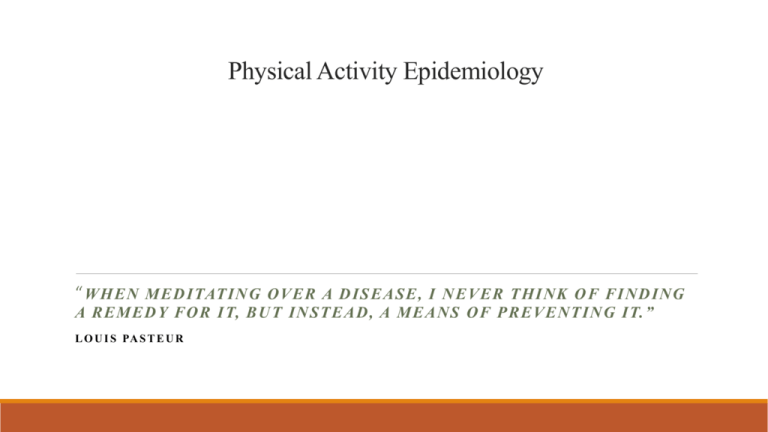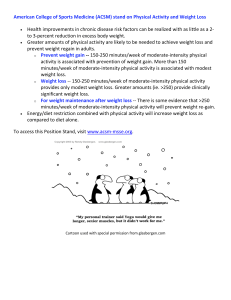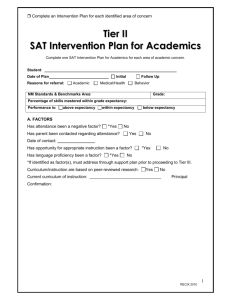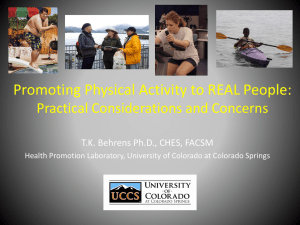Physical Activity Epidemiology
advertisement

Physical Activity Epidemiology “ WH EN MED I TAT I N G O VER A D I S EAS E, I N EVER T H I N K O F FI N D I N G A REMED Y FO R IT, BU T IN S TEAD , A MEAN S O F PREVEN TIN G IT. ” L O U I S PA S T E U R Introduction •This book is about the role played by physical activity (PA) in public health, namely, preventing chronic diseases and premature death. •It is about population medicine more than clinical medicine, which focuses on the care of individuals, usually people who are already sick. •Treatment can be in the form of secondary prevention—reducing the odds that a disease will recur, or tertiary prevention,--minimizing the negative impact of a disease on one’s quality of life. •Epidemiology is more aligned with population medicine, which focuses on a community of individual’s and includes those not sick. • The main goals of population medicine are the control and primary prevention of disease within a large group of people. • People who are at risk for developing a disease are identified, and measures are then taken to reduce those odds by identifying and altering factors that cause disease. Introduction •This book is also about why physical inactivity is a burden on public health and what can be done about it. •In addition to the cost of human suffering resulting from poor health, the financial burden of poor health is great. • About 18 cents of every dollar in the USA is spent on some aspect of health care. • The cost for each person in the USA was about $8,000 in 2007 and is approaching about $9,000 a year which is higher than in other leading economies worldwide including Canada, France, Germany, Japan and the UK—all of which, have longer life expectancies (p-xvi). •Disease stats for USA adults, 2007 on page xvii Table 0.1 • CVD’s—the most common and the most deadly—along with being the most expensive! • Thus, the # of people affected, odds of death, and overall financial burden make a strong case that the highest priority for public health is determining whether and to what extent PA protects against CHD—which is a type of CVD. • Figure 0.4 shows that many deaths in the USA might be attributable to exposure to 12 risk factors. 12 Risk Factors 1. Smoking 2. High Blood Pressure 3. Overweight or Obesity 4. Physical inactivity 5. High blood glucose 6. High LDL cholesterol 7. High dietary sodium (salt) 8. Low dietary omega-3 fatty acids (seafood) 9. High dietary trans fatty acids 10. Alcohol use 11. Low intake of fruits and vegetables 12. Low PUFA (in place of SFA) Introduction •Disease: is medically defined as reduced, abnormal, or lost structure or function of cells, organs, or systems of the body. (xix) •The main goals of population medicine are the control and primary prevention of disease within a large group of people. •Health: is a state of complete physical, mental, and social well-being and not merely the absence of disease or infirmity (WHO 1946). • Hence, health is relative rather than absolute. Lost function results from illness, but it can also occur in the absence of disease. • For example, muscle atrophy after insufficient use regardless of whether someone has disease or not. • Much of this book is about aging—because the odds a person will develop a chronic disease increase directly as they age. The primary risk factor for disease and death—naturally increase with age. • “The longer you live, the closer you are to dying.” Pink Floyd--Time “Tired of lying in the sunshine staying home to watch the rain You are young and life is long and there is time to kill today And then one day you find ten years have got behind you No one told you when to run, you missed the starting gun And you run and you run to catch up with the sun but it's sinking Racing around to come up behind you again The sun is the same in a relative way, but you're older Shorter of breath and one day closer to death.” Dark Side of the Moon Introduction •The following chapters in our book focus on the evidence that PA can help reduce the risks of major chronic diseases that negatively affect health life expectancy. •The WHO defined healthy life expectancy as disability-adjusted life expectancy; the USA ranks 38th worldwide, with a per capita healthy life expectancy of 78.2 years. • Per capita is a Latin prepositional phrase: per and capita. The phrase thus means "by heads" or "for each head", i.e. per individual/person. • The goal are for people to get sick later, lose function more slowly, live longer, and then die quickly when it’s time. This book is about the quality of years lived, as well as the number of years lived. • People with low PA are twice as likely to die early and 50% less likely to report excellent health prior to death compared to people who stay physically active as they age. •Etiology: is the study of causation, or origination. •PA epidemiology emerged as a new field of study about 60 years ago and has expanded to include intervention during the past 25 years as its scientific understanding has grown. • However, the ideas that underlie the field are not new but based in antiquity, dating to the use of structured exercise for health promotion in China around 2500 BC. “Eating alone will not keep a man well; he must also take exercise. For food and exercise, while possessing opposite qualities, yet work together to produce health…And it is necessary…to discern the power of various exercises, both natural exercises and artificial, to know which of them tends to increase flesh and which to lessen it; and not only this; but also to proportion exercise to bulk of food, to the constitution of the patient, to the age of the individual…Exercise should be many and of all kinds, running on the double track increased gradually…sharp walks after exercises, short walks in the sun after dinner, many walks in the early morning, quiet to begin with, increasing till they are violent and then gently finishing.” Hippocrates [Regimen in Health](460-377 BC). Father of Medicine and the first Epidemiologist. “Anyone who lives a sedentary life and does not exercise…even if he eats good foods and takes care of himself according to proper medical principles—all his days will be painful ones and his strength shall wane…The most beneficial of all types of exercise is physical gymnastics to the point that the soul rejoices.” Rabbi Moses ben Maimum (Maimonides) 12th Century. P-5 Four Levels of Physical Activity The Advisory Committee report provides the basis for dividing the amount of aerobic physical activity an adult gets every week into four categories: inactive, low, medium, and high (see table below). This classification is useful because these categories provide a rule of thumb of how total amount of physical activity is related to health benefits. Low amounts of activity provide some benefits; medium amounts provide substantial benefits; and high amounts provide even greater benefits. Classification of Total Weekly Amounts of Aerobic Physical Activity Into Four Categories Levels of Physical Activity Range of Moderate-Intensity Minutes a Week Summary of Overall Health Benefits Comment Inactive No activity beyond baseline None Being inactive is unhealthy. Low Activity beyond baseline but fewer than 150 minutes a week Some Low levels of activity are clearly preferable to an inactive lifestyle. Substantial Activity at the high end of this range has additional and more extensive health benefits than activity at the low end. Additional Current science does not allow researchers to identify an upper limit of activity above which there are no additional health benefits. Medium High 150 minutes to 300 minutes a week More than 300 minutes a week Inactive is no activity beyond baseline activities of daily living. Low activity is activity beyond baseline but fewer than 150 minutes (2 hours and 30 minutes) of moderate-intensity physical activity a week or the equivalent amount (75 minutes, or 1 hour and 15 minutes) of vigorous-intensity activity. Medium activity is 150 minutes to 300 (5 hours) minutes of moderate-intensity activity a week (or 75 to 150 minutes of vigorous-intensity physical activity a week). In scientific terms, this range is approximately equivalent to 500 to 1,000 metabolic equivalent (MET) minutes a week. High activity is more than the equivalent of 300 minutes of moderate-intensity physical activity a week. The Bible and Fitness First Corinthians 6:19-20 says, "Or do you not know that your body is a temple of the Holy Spirit within you, whom you have from God? You are not your own, for you were bought with a price. So glorify God in your body." First Timothy 4:7b-8 says, "Rather train yourself for godliness; for while bodily training is of some value, godliness is of value in every way, as it holds promise for the present life and also for the life to come." These two verses are a beautiful illustration of the Bible's balanced view regarding health. Our bodies are of value to God. He cares not only about our souls, but also about our bodies. When God created man, He made him a physical being. He also gave man food and labor (Genesis 1:28-31). Psalm 139:13-14 talks about God knitting us together in our mother's womb. Jesus told His followers that God knew about their physical needs and would provide for them (Matthew 6:32). Jesus Himself provided food for people (Luke 9:10-17; Mark 8:1-8; John 2:6-11) and physical healing (Matthew 4:23; Acts 10:38). The fact that Jesus came to Earth in bodily form further demonstrates God's regard for our physical beings. Paul tells believers bluntly that their bodies are from God; therefore, believers should honor God with their bodies. We are called to steward our bodies as temples of the Holy Spirit. If we do not care for our health, we are neglecting God's temple. Read more: http://www.compellingtruth.org/Bible-exercise-health.html#ixzz3B3pvmIrk





